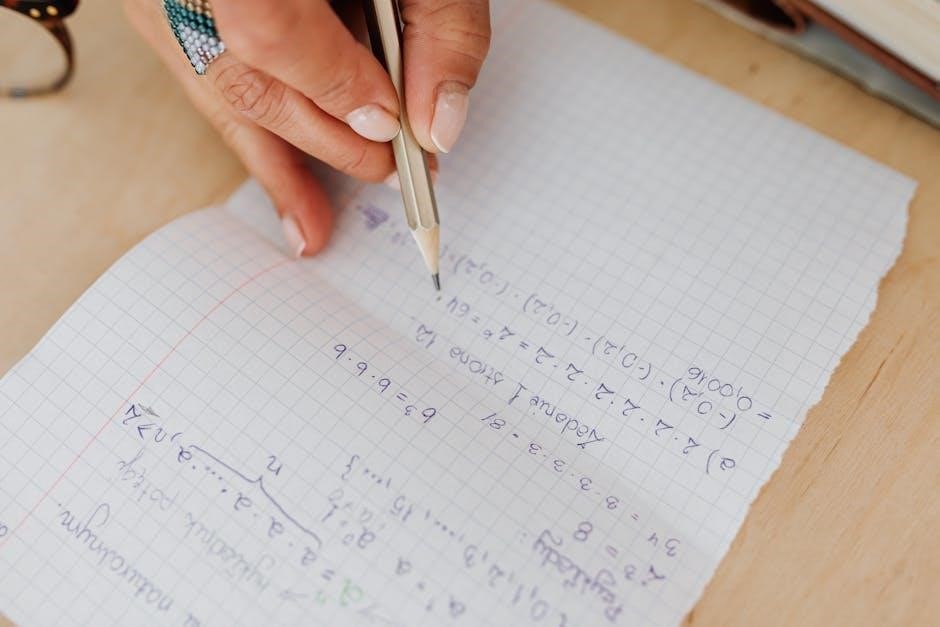Quadratic equations are polynomial equations of degree two, expressed as ax² + bx + c = 0․ Factoring is a key method for solving these equations by breaking them into simpler terms, allowing students to find roots efficiently․ These equations are fundamental in algebra and have real-world applications in physics, engineering, and more․ Educational resources, like PDF worksheets, provide practice problems and examples to master factoring techniques․
Definition and Standard Form
A quadratic equation is a polynomial equation of degree two, expressed in the form ( ax^2 + bx + c = 0 ), where ( a ), ( b ), and ( c ) are constants, and ( a
eq 0 )․ The standard form is essential for identifying and solving quadratic equations․ The term ( ax^2 ) represents the quadratic term, ( bx ) is the linear term, and ( c ) is the constant term․ This structure allows for various solving methods, including factoring, completing the square, and the quadratic formula․ Understanding the standard form is crucial for simplifying and solving quadratic equations effectively․ Resources like PDF worksheets provide practice in rewriting equations in standard form and applying factoring techniques to find solutions․
Importance of Factoring in Solving Quadratic Equations
Factoring is a cornerstone of solving quadratic equations as it simplifies complex expressions into manageable factors․ This method allows students to identify roots without relying on the quadratic formula or completing the square․ By breaking down equations into binomials, factoring provides a clear pathway to finding solutions․ It also enhances understanding of polynomial structures and their relationships․ Educational resources, such as PDF worksheets, emphasize factoring due to its efficiency and applicability in various algebraic problems․ Mastery of factoring builds a strong foundation for advanced math concepts and problem-solving strategies․ Regular practice with worksheets helps students grasp this essential skill, reinforcing their ability to tackle quadratic equations confidently․

The Process of Factoring Quadratic Equations
The process involves expressing the equation in standard form, identifying common factors, and breaking the polynomial into simpler expressions․ This step-by-step approach simplifies solving for roots․

Step 1: Write the Equation in Standard Form
The first step in factoring quadratic equations is to ensure the equation is in standard form, which is ax² + bx + c = 0․ This involves rearranging terms if necessary and combining like terms․ If the equation is not already set to zero, move all terms to one side by adding or subtracting as needed․ For example, if the equation is x² + 5x = 12, subtract 12 from both sides to get x² + 5x ‒ 12 = 0․ This step is crucial because factoring requires the equation to be in the standard quadratic form․ Once the equation is properly formatted, the next steps in factoring can proceed smoothly․ Always double-check that the equation is simplified and set to zero before attempting to factor․
Step 2: Factor the Polynomial
After writing the equation in standard form, the next step is to factor the quadratic polynomial․ This involves expressing the quadratic expression as a product of two binomials․ To factor effectively, identify the coefficients and look for two numbers that multiply to (a imes c) and add up to (b)․ For example, in the equation (x^2 + 5x ౼ 12 = 0), the numbers 7 and -4 work because (7 imes -4 = -28) and (7 + (-4) = 3)․ This allows the polynomial to be factored as ((x + 7)(x ౼ 4) = 0)․ Always check if the factors can be further simplified, such as in the case of perfect square trinomials or difference of squares․ Practice is key to mastering this step․

Step 3: Apply the Zero Product Property
Once the quadratic equation is factored into the product of two binomials, set each factor equal to zero and solve for the variable․ This is known as the Zero Product Property, which states that if the product of two factors is zero, at least one of the factors must be zero․ For example, if the factored form is (x + 7)(x ‒ 4) = 0, then x + 7 = 0 or x ౼ 4 = 0, leading to solutions x = -7 and x = 4․ Always verify the solutions by substituting them back into the original equation to ensure they satisfy the equation․ This step confirms the roots of the quadratic equation․

Different Methods of Factoring
There are several methods to factor quadratic expressions, including factoring trinomials, perfect square trinomials, difference of squares, and factoring by grouping․ Each method targets specific patterns․
Factoring Trinomials
Factoring trinomials involves breaking down quadratic expressions into the product of two binomials․ Start by identifying the greatest common factor (GCF) and factoring it out․ For trinomials in the form ax² + bx + c, look for two numbers that multiply to ac and add to b․ These numbers help create the factors․ For example, in x² + 7x + 10, the numbers 5 and 2 work, resulting in (x + 5)(x + 2)․ Practice with worksheets like those from Kuta Software or Mathleaks helps master this skill․ Always check solutions by expanding the factors to ensure they match the original trinomial․ This method is essential for solving quadratic equations efficiently․ Regular practice improves speed and accuracy in factoring․
Factoring Perfect Square Trinomials
Perfect square trinomials are quadratic expressions that can be written as the square of a binomial․ They follow the pattern (a^2 + 2ab + b^2 = (a + b)^2)․ For example, (x^2 + 6x + 9) factors to ((x + 3)^2)․ To identify these, look for a first term that’s a perfect square, a last term that’s also a perfect square, and a middle term that’s twice the product of the square roots of the first and last terms․ Practice worksheets, such as those from Kuta Software, often include exercises specifically for perfect squares․ These resources help students master the ability to recognize and factor such trinomials efficiently, which is crucial for solving quadratic equations․ Regular practice with these patterns enhances problem-solving speed and accuracy․

Factoring Difference of Squares
The difference of squares is a special factoring pattern that applies to expressions of the form (a^2 ‒ b^2), which factors into ((a ‒ b)(a + b))․ This method is particularly useful for quadratics that fit this structure․ For example, (x^2 ౼ 16) factors into ((x ౼ 4)(x + 4)), and (y^2 ౼ 9y + 20) can be rewritten as ((y ‒ 5)(y ౼ 4))․ Worksheets often include exercises like (x^2 ‒ 64), which factors into ((x ౼ 8)(x + 8))․ Recognizing this pattern allows students to factor such expressions quickly and efficiently․ Practice resources, such as those from Kuta Software, provide numerous exercises to master this technique, essential for solving quadratic equations․ Regular practice helps students identify and apply the difference of squares pattern effectively․
Factoring by Grouping
Factoring by grouping is a method used to factor polynomials when no common monomial factor exists, but the polynomial can be divided into groups that share common factors․ For example, consider the polynomial (x^2 + x ౼ 6)․ To factor by grouping, split the terms into pairs: ((x^2 + x) + (-6))․ Factor out the greatest common factor (GCF) from each group, resulting in (x(x + 1) ౼ 6)․ However, this method works best when the grouped terms lead to a common binomial factor․ Worksheets often include problems like (x^2 + 3x ‒ 4), which factors into ((x + 4)(x ‒ 1))․ Regular practice with such exercises, as found in resources like Kuta Software, helps students master this technique․ Factoring by grouping is a valuable skill for solving quadratic equations efficiently․

Solving Quadratic Equations by Factoring
Solving quadratic equations by factoring involves setting the equation to zero, factoring the polynomial, and applying the Zero Product Property to find the solutions․ This method simplifies finding the roots of quadratic equations without using the quadratic formula, making it a foundational skill in algebra․ Factoring techniques, such as trinomials, perfect squares, and difference of squares, are essential for efficiently solving these equations․ Regular practice with worksheets, like those from Kuta Software, helps students master this process, ensuring they can solve quadratic equations confidently and accurately․
Setting the Factored Form Equal to Zero
Setting the factored form of a quadratic equation equal to zero is a critical step in solving it․ After factoring the quadratic equation into two binomials, such as (x + a)(x + b) = 0, each factor is set to zero․ This means solving for x in each binomial separately, resulting in the solutions x = -a and x = -b․ For example, if the equation factors to (x ౼ 3)(x + 4) = 0, setting each factor equal to zero gives x = 3 and x = -4 as solutions․ This method relies on the Zero Product Property, which states that if the product of two factors is zero, at least one of the factors must be zero․ Always check the solutions to ensure they do not result in division by zero or invalid expressions․ This step-by-step approach ensures accurate and efficient problem-solving․

Using the Zero Product Property
The Zero Product Property states that if the product of two factors is zero, then at least one of the factors must be zero․ This property is essential for solving quadratic equations once they are factored․ For example, if a quadratic equation is factored as (x + 3)(x ౼ 2) = 0, setting each factor equal to zero gives the solutions x = -3 and x = 2․ This method ensures that all potential solutions are found efficiently․ The property relies on the factored form of the equation, making it a cornerstone of algebraic problem-solving․ By applying this principle, students can systematically determine the roots of quadratic equations․ Always verify the solutions by substituting them back into the original equation to ensure accuracy․ This step reinforces understanding and avoids errors․
Checking Solutions
Checking solutions is a crucial step after factoring quadratic equations to ensure accuracy․ Once the roots are found, substitute each value back into the original equation to verify equality․ For example, if solving ( x^2 ౼ 5x + 6 = 0 ) yields ( x = 2 ) and ( x = 3 ), plug these values into the equation to confirm both sides balance․ This step helps identify any extraneous solutions or errors in factoring․ Accurate verification reinforces understanding and builds confidence in problem-solving skills․ Regularly practicing this method ensures mastery of quadratic equations and prepares students for more complex algebraic challenges․ Always double-check solutions to maintain precision and reliability in mathematical problem-solving․ This habit is essential for long-term success in mathematics․

Practice Worksheets and Resources
Access free PDF worksheets for solving quadratic equations by factoring from platforms like Kuta Software and Mathleaks․ These resources provide step-by-step examples and practice problems covering trinomials, perfect squares, and difference of squares․ Utilize these tools to master factoring techniques and improve problem-solving skills through hands-on practice․
Downloading Free PDF Worksheets
Free PDF worksheets for solving quadratic equations by factoring are widely available online․ Platforms like Kuta Software and Mathleaks offer downloadable resources with practice problems, examples, and solutions․ These worksheets cover various factoring techniques, including trinomials, perfect squares, and difference of squares․ Many PDFs are designed for specific skill levels, catering to both beginners and advanced learners․ Some resources require a password for access, while others are freely available for immediate download․ These worksheets are ideal for self-study, homework assistance, or classroom use, providing students with hands-on practice to master quadratic factoring․ They often include answer keys, enabling learners to verify their progress and understanding․ Downloading these PDFs is a convenient way to enhance problem-solving skills in factoring quadratics․
Using Kuta Software for Practice
Kuta Software is a valuable resource for practicing quadratic equations by factoring․ It offers free downloadable PDF worksheets with a variety of problems, ranging from basic to advanced․ Each worksheet includes step-by-step examples and solutions, making it easier for students to understand and apply factoring techniques․ The software provides progressive difficulty, starting with simple trinomials and moving to more complex polynomials․ Teachers and students can access these worksheets directly from the Kuta Software website, ensuring convenient practice․ The clear formatting and comprehensive answer keys make it an excellent tool for self-study or classroom use․ Kuta Software is widely recommended for mastering quadratic factoring due to its structured and detailed approach․
Additional Online Resources
Beyond Kuta Software, numerous online platforms offer free PDF worksheets and interactive tools for mastering quadratic equations by factoring․ Websites like Mathleaks provide detailed Algebra 1 worksheets covering topics such as factoring trinomials and solving quadratic equations․ BBC Sport and other educational sites offer live problem-solving exercises and video tutorials․ Many resources include step-by-step examples, answer keys, and progress tracking features․ These tools cater to both students and teachers, ensuring comprehensive practice and understanding․ They also support various learning styles, making it easier to grasp factoring techniques․ By leveraging these resources, learners can enhance their problem-solving skills and build confidence in tackling quadratic equations effectively․

Common Mistakes and Tips
Common errors include incorrect factoring, forgetting to set equations to zero, and not checking solutions․ Double-check signs, ensure complete factoring, and verify solutions for accuracy in quadratic equations․
Identifying and Avoiding Common Errors
When solving quadratic equations by factoring, common errors include incorrect factorization of trinomials, forgetting to set the equation to zero, and not verifying solutions․ Students often misidentify the signs of factors or fail to check if solutions satisfy the original equation․ To avoid these mistakes, double-check the factoring process, ensure all terms are included, and verify solutions by substitution․ Pay attention to negative signs and ensure factors multiply to the constant term and add to the middle coefficient․ Using tools like the Zero Product Property correctly can also help prevent errors․ Practicing with worksheets and reviewing examples can improve accuracy and reduce common pitfalls in factoring quadratic equations․
Best Practices for Factoring Quadratics
Mastering factoring quadratics requires consistent practice and adherence to key strategies․ Always start by ensuring the equation is in standard form, (ax^2 + bx + c = 0)․ Look for common factors in all terms before attempting to factor․ For trinomials, identify two numbers that multiply to (ac) and add to (b)․ Use methods like grouping or the AC method for more complex cases․ Once factored, set each factor equal to zero and solve using the Zero Product Property․ Verify solutions by substituting them back into the original equation․ Regular practice with worksheets and resources like Kuta Software can improve skills․ Breaking problems into smaller steps ensures clarity and reduces errors, helping to build confidence in factoring quadratic expressions effectively․



